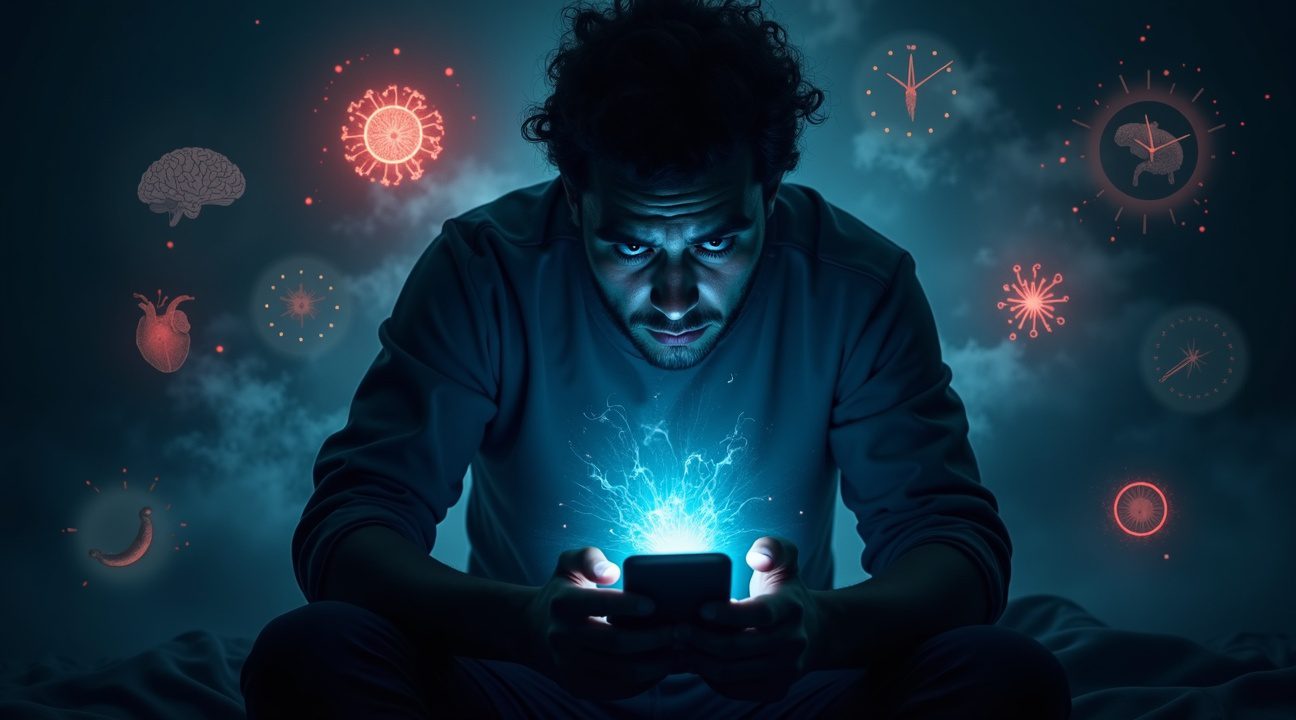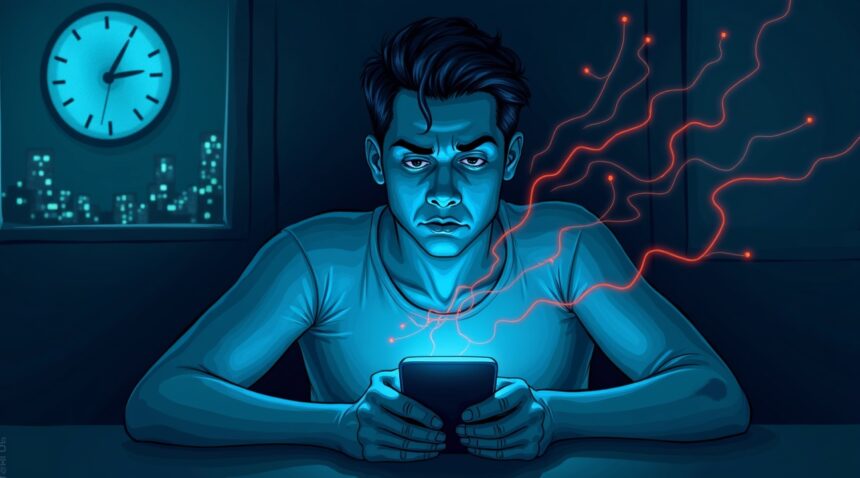Constant exposure to negative digital content activates the same biological alarm systems that evolved to respond to immediate physical threats. This flooding of stress hormones like cortisol and adrenaline occurs without any opportunity for natural recovery. Research shows that this habitual consumption of distressing news creates measurable psychological damage. People experience increased distress, decreased life satisfaction, and reduced mental wellbeing. Simultaneously, this pattern generates future anxiety that perpetuates the destructive cycle.
Key Takeaways
- Biological stress response activation: Doomscrolling activates the hypothalamic-pituitary-adrenal (HPA) axis, releasing cortisol and adrenaline as if facing real physical threats. This leads to chronic physiological arousal without resolution.
- Measurable mental health decline: Studies reveal strong correlations between excessive negative news consumption and increased psychological distress. People show reduced life satisfaction and decreased mental wellbeing across multiple validated measures.
- Physical health consequences: Chronic stress from continuous negative content exposure causes sleep disturbances, elevated blood pressure, and weakened immune function. Digestive issues and persistent fatigue also result from this pattern.
- Future anxiety cycle: Psychological distress from doomscrolling generates anxiety about the future, which then drives more compulsive news consumption. This creates a self-perpetuating cycle of hopelessness and negative expectations.
- Community-wide impact: Widespread doomscrolling weakens social bonds and reduces community engagement. This creates collective anxiety that undermines group resilience and collaborative problem-solving abilities.
Your Body Treats Doomscrolling Like a Real Crisis
I’ve discovered that our bodies can’t distinguish between reading about a crisis on social media and experiencing an actual emergency firsthand. Doomscrolling refers to the habitual consumption of large amounts of negative news or social media content, particularly bad news and pessimistic stories. When someone mindlessly scrolls through endless feeds of alarming headlines and distressing updates, their brain interprets this information as immediate threats requiring action.
The Biological Alarm System Kicks In
Repeated exposure to negative and alarming content triggers the body’s stress response, activating the hypothalamic-pituitary-adrenal (HPA) axis and increasing the release of stress hormones such as cortisol. This ancient survival mechanism evolved to help humans respond to physical dangers like predators or natural disasters. However, modern digital consumption patterns hijack this system in ways our ancestors never experienced.
The HPA axis functions like a sophisticated alarm network throughout the body. When the brain perceives threat signals from negative news content, it immediately signals the hypothalamus to release hormones that cascade through the pituitary gland and ultimately reach the adrenal glands. These glands then flood the bloodstream with cortisol and adrenaline, preparing the body for fight-or-flight responses that never come.
This constant state of physiological arousal becomes particularly problematic because digital media provides an endless stream of potential stressors. Unlike our ancestors who faced discrete threats with clear beginnings and endings, modern doomscrollers expose themselves to continuous waves of alarming information without any resolution or recovery period.
Physical Consequences Mount Over Time
Chronic stress responses due to constant doomscrolling can lead to sleep disturbances, headaches, elevated blood pressure, decreased immune function, and other physical symptoms. I’ve observed that people who engage in heavy negative news consumption often report feeling physically exhausted despite spending hours sitting still. This fatigue stems from their bodies maintaining heightened alert states for extended periods.
Sleep becomes particularly affected because elevated cortisol levels interfere with natural circadian rhythms. Many doomscrollers find themselves lying awake at night, replaying disturbing news stories or feeling anxious about global events beyond their control. The blue light from screens compounds this issue by suppressing melatonin production, but the psychological activation from distressing content creates an even more significant barrier to restful sleep.
Cardiovascular health suffers as blood pressure remains elevated during prolonged stress responses. The heart continues pumping at accelerated rates designed for physical action that never occurs. Meanwhile, stress impacts mental health in ways that compound these physical symptoms, creating cycles where psychological distress amplifies bodily reactions.
Immune function deteriorates under chronic stress because cortisol suppresses inflammatory responses and reduces white blood cell effectiveness. This leaves regular doomscrollers more susceptible to infections and slower to recover from illnesses. The body essentially prioritizes immediate survival responses over long-term health maintenance.
Digestive issues frequently emerge as stress hormones disrupt normal gut function. Many people experience stomach problems, changes in appetite, or digestive irregularities that correlate directly with their news consumption habits. The gut-brain connection ensures that psychological stress manifests physically in multiple body systems.
Headaches and muscle tension represent common manifestations of chronic stress activation. The body maintains defensive postures and muscular readiness that would normally relax after threats pass. However, continuous exposure to negative digital content prevents this natural recovery cycle from completing.
Understanding how technology impacts human psychology helps explain why these physical symptoms develop so readily from seemingly passive activities like scrolling through news feeds. The human stress response system simply wasn’t designed to handle the volume and intensity of negative information that modern digital platforms deliver directly to our personal devices throughout each day.

The Numbers Don’t Lie: How Doomscrolling Destroys Mental Health
Research reveals the devastating psychological toll of compulsive negative news consumption. A comprehensive study of 460 participants uncovered stark evidence that doomscrolling triggers measurable damage to mental health and overall quality of life.
Statistical Evidence of Psychological Damage
The study identified strong correlations between doomscrolling habits and multiple mental health indicators. Participants who engaged in excessive negative news consumption showed a significant increase in psychological distress (r = 0.391, p < .01). This correlation demonstrates that frequent exposure to distressing content doesn’t just feel bad—it creates lasting psychological strain.
Even more concerning, doomscrolling caused marked decreases across key wellbeing measures. Life satisfaction dropped substantially (r = −0.290, p < .01), while mental wellbeing suffered similar declines (r = −0.296, p < .01). Participants also reported reduced harmony in life (r = −0.290, p < .01), suggesting that constant negative content consumption disrupts people’s sense of balance and peace.
The research confirms what many people already suspect: stress and mental health deteriorate significantly with prolonged exposure to distressing digital content. These aren’t just temporary mood changes—they represent fundamental shifts in psychological functioning.
The Mediation Effect: Understanding How Damage Spreads
Structural equation modeling provided deeper insights into how doomscrolling creates cascading mental health problems. Psychological distress acts as a critical mediator between doomscrolling behaviors and negative outcomes. This means the initial stress from consuming upsetting content triggers a chain reaction that amplifies damage across multiple areas of mental health.
The mediation effects proved substantial, with indirect effects ranging from β = −0.165 to β = −0.282. These findings indicate that psychological distress doesn’t just accompany doomscrolling—it actively transmits the harmful effects to other aspects of wellbeing. The pattern suggests that once distress takes hold, it systematically undermines life satisfaction, mental wellness, and personal harmony.
Understanding this mediation process reveals why breaking free from doomscrolling requires more than willpower. The psychological distress it creates becomes self-perpetuating, making it harder to step away from negative content. Technology impacts human psychology in ways that can trap users in destructive consumption patterns.
These findings establish clear connections between doomscrolling and depression, anxiety, and reduced wellbeing. The research provides concrete evidence that constant exposure to negative news creates measurable psychological harm that extends far beyond temporary discomfort.
Why Doomscrolling Makes Tomorrow Feel Hopeless
I’ve discovered that doomscrolling creates a vicious cycle where consuming negative news directly damages our ability to see the future positively. This isn’t just about feeling sad after reading bad news—it’s about fundamentally altering how we process and anticipate what’s coming next.
The Psychological Mechanism Behind Future Anxiety
Research involving 402 adults reveals exactly how this destructive pattern unfolds. Psychological distress strongly predicted future anxiety with a correlation of β = 0.64, p < .001, which then drove people to engage in more doomscrolling behavior at β = 0.40, p < .001. The data shows that 55% of the total effect was indirect, confirming that future anxiety acts as a powerful mediator between general psychological distress and compulsive news consumption.
This mediation effect explains why people can’t simply stop scrolling through negative content. When individuals experience psychological stress, their brains begin generating anxious thoughts about the future. These worries then compel them to seek more information, believing that staying informed will help them regain control. Instead, the constant stream of negative information reinforces their fears and creates deeper hopelessness about what lies ahead.
The brain interprets this flood of negative information as evidence that the world is becoming increasingly dangerous and unpredictable. Technology impacts human psychology in ways that can trap users in cycles of negative reinforcement, making them more susceptible to developing pessimistic worldviews.
How Pessimism Takes Root
Doomscrolling fundamentally changes how people process uncertainty and manage negative emotions during challenging times. During pandemics, natural disasters, or social upheaval, individuals who engage in excessive negative news consumption develop increasingly pessimistic outlooks that persist long after the immediate crisis passes.
The constant exposure to worst-case scenarios trains the brain to expect negative outcomes as the default. This conditioning makes it extremely difficult to envision positive possibilities or maintain hope during uncertain periods. People begin interpreting neutral or ambiguous situations through a lens of impending doom, creating a self-fulfilling prophecy where their expectations shape their reality.
Stress and mental health become increasingly intertwined as this pattern continues. The brain’s stress response system becomes hypervigilant, constantly scanning for threats and interpreting everyday challenges as confirmation that the future holds only negative outcomes.
I’ve observed that this pessimistic shift affects decision-making in profound ways. People become paralyzed by the belief that their actions won’t matter because everything is destined to go wrong anyway. They stop making long-term plans, avoid taking positive risks, and withdraw from activities that previously brought them joy or fulfillment.
The emotional regulation difficulties that accompany doomscrolling make it even harder to break free from these negative thought patterns. When faced with uncertainty, instead of using healthy coping mechanisms like problem-solving or seeking social support, individuals reflexively return to their screens for more information. This behavior provides temporary relief from anxiety but ultimately strengthens the neural pathways associated with hopelessness and despair.
Breaking this cycle requires conscious effort to limit negative news consumption and actively cultivate more balanced perspectives about the future. Pop culture influences can also play a role in either reinforcing or countering these negative patterns, depending on the content people choose to consume instead of endless negative news feeds.

Beyond Personal Pain: How Doomscrolling Damages Communities
I’ve observed that doomscrolling isn’t just an individual problem—it’s a collective crisis that tears through the fabric of our communities. Research using validated Doomscrolling Scale instruments reveals strong connections between this behavior and specific personality traits, social media addiction, and fear of missing out (FOMO). These measurement tools consistently demonstrate how excessive negative news consumption affects both personal and social well-being outcomes.
The Ripple Effect of Collective Anxiety
When entire communities engage in doomscrolling simultaneously, the effects multiply exponentially. I see how stress and mental health challenges spread like wildfire through social networks. Group mood deteriorates as people share increasingly distressing content, creating echo chambers of anxiety and despair. This collective exposure to negative media cycles undermines community resilience—our shared ability to bounce back from challenges and support one another during difficult times.
The personality traits most strongly associated with doomscrolling behaviors include:
- High neuroticism
- Low emotional stability
- Heightened sensitivity to threats
Individuals with these characteristics often become unwitting amplifiers of community distress. Their compulsive sharing of alarming content triggers similar responses in others, particularly those vulnerable to FOMO-driven behaviors.
Social Harmony Under Siege
I notice that technology impacts human psychology in ways that fracture social bonds. Communities experiencing widespread doomscrolling often struggle with decreased empathy, increased polarization, and reduced capacity for collaborative problem-solving. Social media addiction compounds these issues by creating dependency on negative stimulation for emotional regulation.
The validated Doomscrolling Scale measurements consistently show correlations between high doomscrolling scores and:
- Decreased community engagement
- Withdrawal from local initiatives
- Loss of meaningful social connections
This withdrawal weakens the social fabric that traditionally helped communities weather storms together.
Fear of missing out drives people to consume more negative content, believing they need constant updates to stay informed. However, this behavior actually reduces their ability to contribute positively to community well-being. Instead of fostering informed citizenship, excessive negative media consumption creates paralyzed, anxious populations unable to take constructive action. Pop culture influences reinforce these patterns by normalizing constant connectivity and crisis consumption as responsible behavior.
Sources:
BMC Psychology – “The Numbers Don’t Lie: How Doomscrolling Destroys Mental Health”
BMC Public Health – “Why Doomscrolling Makes Tomorrow Feel Hopeless”


